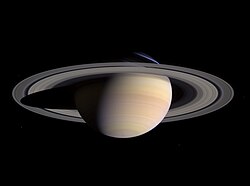Portal:Astronomia/Artykuł miesiąca 2 2008
Saturn jest szóstą planetą Układu Słonecznego według oddalenia od Słońca. Jest to gazowy olbrzym, drugi pod względem masy i wielkości po Jowiszu, a przy tym paradoksalnie o najmniejszej gęstości ze wszystkich planet całego Układu Słonecznego. Saturn znany był już w świecie starożytnym. Charakterystyczną jej cechą są pierścienie składające się głównie z lodu i (w mniejszej ilości) z odłamków skalnych. Obecnie znamy 61 naturalnych satelitów Saturna (3 niepotwierdzone ostatecznie). Nazwa planety pochodzi od imienia rzymskiego boga - Saturna.
Media użyte na tej stronie
Saturn Cassini-Huygens (NASA)
Instrument: Imaging Science Subsystem - Narrow Angle
Saturn's peaceful beauty invites the Cassini spacecraft for a closer look in this natural color view, taken during the spacecraft's approach to the planet. By this point in the approach sequence, Saturn was large enough that two narrow angle camera images were required to capture an end-to-end view of the planet, its delicate rings and several of its icy moons. The composite is made entire from these two images.
Moons visible in this mosaic: Epimetheus (116 kilometers, 72 miles across), Pandora (84 kilometers, 52 miles across) and Mimas (398 kilometers, 247 miles across) at left of Saturn; Prometheus (102 kilometers, 63 miles across), Janus (181 kilometers, 113 miles across) and Enceladus (499 kilometers, 310 miles across) at right of Saturn.
The images were taken on May 7, 2004 from a distance of 28.2 million kilometers (17.6 million miles) from Saturn. The image scale is 169 kilometers (105 miles) per pixel. Moons in the image have been brightened for visibility.
The Cassini-Huygens mission is a cooperative project of NASA, the European Space Agency and the Italian Space Agency. The Jet Propulsion Laboratory, a division of the California Institute of Technology in Pasadena, manages the Cassini-Huygens mission for NASA's Office of Space Science, Washington, D.C. The Cassini orbiter and its two onboard cameras, were designed, developed and assembled at JPL. The imaging team is based at the Space Science Institute, Boulder, Colo.
For more information, about the Cassini-Huygens mission visit, http://saturn.jpl.nasa.gov and the Cassini imaging team home page, http://ciclops.org.
